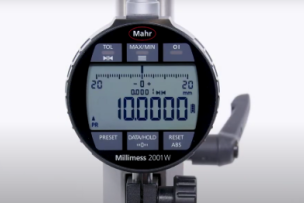Headquartered in Aurora, IL, Mitutoyo America Corporation is the world's largest provider of measurement and inspection solutions offering the most complete selection of machines, sensors, systems and services with a line encompassing CMM (coordinate measuring machines), vision, form and finish measuring machines, as well as precision tools and instruments, and metrology data management software. Mitutoyo's nationwide network of Metrology Centers and support operations provides application, calibration, service, repair and educational programs to ensure that our 8,500+ metrology products will deliver measurement solutions for our customers throughout their lifetime.
Let us start with an unfortunate yet common example of the costly confusion in calibration practice. Say you own a coordinate measuring machine (CMM) and hire somebody to “calibrate the CMM”. What do you think they will do? You select an accredited laboratory and their calibration method follows the ISO standard for CMMs. Good so far. They show up, make some measurements, put a new calibration label on your CMM, and issue a calibration certificate. You feel good and file the certificate. Six months later, a quality auditor shows up and happens to review the CMM calibration certificate. They notice that there are no tolerances on the certificate and no statements of conformity. You start getting a bit nervous, and go find the specifications of the CMM in some old records. As you start to compare the values on the certificate with the specifications of the CMM, you realize that the CMM is significantly out of tolerance, and has been used for months to check critical parts. You have just exposed your organization to huge risks. Can you blame the person who calibrated your CMM? Did they do a proper calibration? Doesn’t calibration include comparison to tolerance? Doesn’t calibration include adjustments to be within specifications? Unfortunately, the answers to these questions are not straightforward or simple.
What is Calibration?
Requirements for calibration appear in most national and international quality standards, and most organizations recognize that measuring equipment must be calibrated. However, there is much confusion regarding the definition of calibration, and this confusion increases quality-related risks to organizations. The purpose of this technical bulletin is to sort out all the different concepts that exist for the term calibration, including official definitions and those in common use. The primary technical basis for this document is ASME B89.7.1-2016, Guidelines for Addressing Measurement Uncertainty, which is one of the few documents that has tried to sort out the calibration conundrum.
The Official Definition
There is an official dictionary of measurement terms called the VIM, the International Vocabulary of Metrology. The VIM, also known as ISO/IEC Guide 99:2007 or JCGM 200:2012, contains terms and definitions that are accepted and utilized at a very high level across national and international standards organizations, government agencies, and regulation bodies. The VIM defines the term calibration as:
Operation that, under specified conditions, in a first step, establishes a relation between the quantity values with measurement uncertainties provided by measurement standards and corresponding indications with associated measurement uncertainties and, in a second step, uses this information to establish a relation for obtaining a measurement result from an indication.
This definition is a bit awkward, but we can see that there are two important “steps” in calibration to understand. The first step is about relating measured values from your measuring equipment to those from calibrated measurement standards. This is the generally understood critical connection between calibration and traceability. Calibration enables the units of measurement on your equipment, like the inch or meter, to be traced back to some official reference (like NIST in the U.S.).
The second step in the definition of calibration is what causes so much trouble, but is so important, as it clarifies that the information gained in the first step is only as good as how it is used. In other words, whatever information is used as the calibration is indeed the calibration, and therefore we need to explore the ways that calibration information is used.
Types of Calibrations
The risk of quality problems increase sharply when an organization requesting “calibration” has different expectations than the organization providing the “calibration”. In an attempt to sort out this calibration confusion, ASME B89.7.1 discusses that measurements associated with calibration have one or more of three different purposes:
(1) Determination of reference values (i.e. calibrated values)
(2) Determine test values associated with verification to tolerance (conformance to a specified requirement)
(3) Determine necessary adjustments to measuring equipment
Reference Values
As an example, when a gage block is calibrated, a measurement is made at a specific point on the surface of the gage block. The measured length becomes the assigned value of the gage block, and when the gage block is subsequently used as a measurement standard, that assigned value becomes the reference value. This assigned reference value is often called the calibrated value. Determining a calibrated reference value, and reporting it on a calibration certificate, which is quite common in calibration practice, is the appropriate “calibration” when the gage block is used in this manner.
Conformance/Verification
Continuing the gage block example, the most common use of gage blocks is to use the nominal value marked on the block as the reference value and not the value from the calibration certificate. In this case, the calibrated reference value is no longer useful as the calibration. Instead, the user of the gage block needs to know if the gage block conforms to specification. For many types of measuring equipment, verification to tolerance limits is the most important aspect of calibration. In these cases, calibration becomes a search for errors, and the calibration method needs to be sufficient, and efficient, in that search. The necessary calibration method may be quite different then the method used to determine and assign a reference value. The issued calibration certificate should include measured values, tolerances, and a statement of conformance. It is also important to note that a new calibration certificate, and calibration label, can be issued even if the measuring equipment is found to be out of tolerance – to avoid that from happening, be clear in expectations when requesting calibration services.
Adjustments to Measuring Equipment
The biggest confusion in calibration is with adjustments to the accuracy of the measuring equipment. A large percentage of U.S. industry believes that calibration, by definition, includes any necessary adjustments to bring the measuring equipment back to within manufacturer specifications. The definition of calibration found in any normal dictionary will support this belief. The definition of calibration from the VIM and other key national and international standards, however, does not support this position, and unfortunately this discrepancy causes problems. The solution is to define clear expectations and to be careful with how the word “calibration” is used when requesting calibration services.
User Calibrations
Another area of confusion with calibration is the difference between the calibrations of measuring equipment that are “official”, as is documented in certificates and used to demonstrate equipment reliability over time, and the calibrations that are done in daily use of the measuring equipment, such as zero setting or gain adjustments when changing a stylus. These “user calibrations” (which have no formal name) are not often recognized as calibrations, but they are in fact very important calibrations that are often used to adjust the accuracy of the measuring equipment.
Previously Featured on Mitutoyo's website.








Talk to Us!
Leave a reply
Your email address will not be published. Required fields are marked *